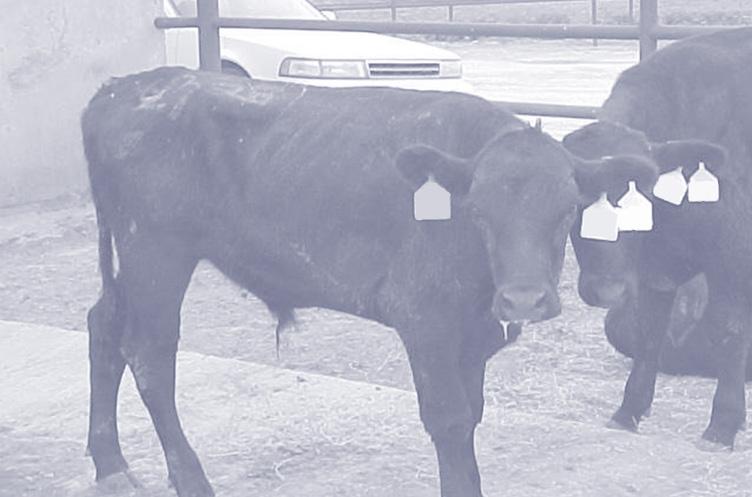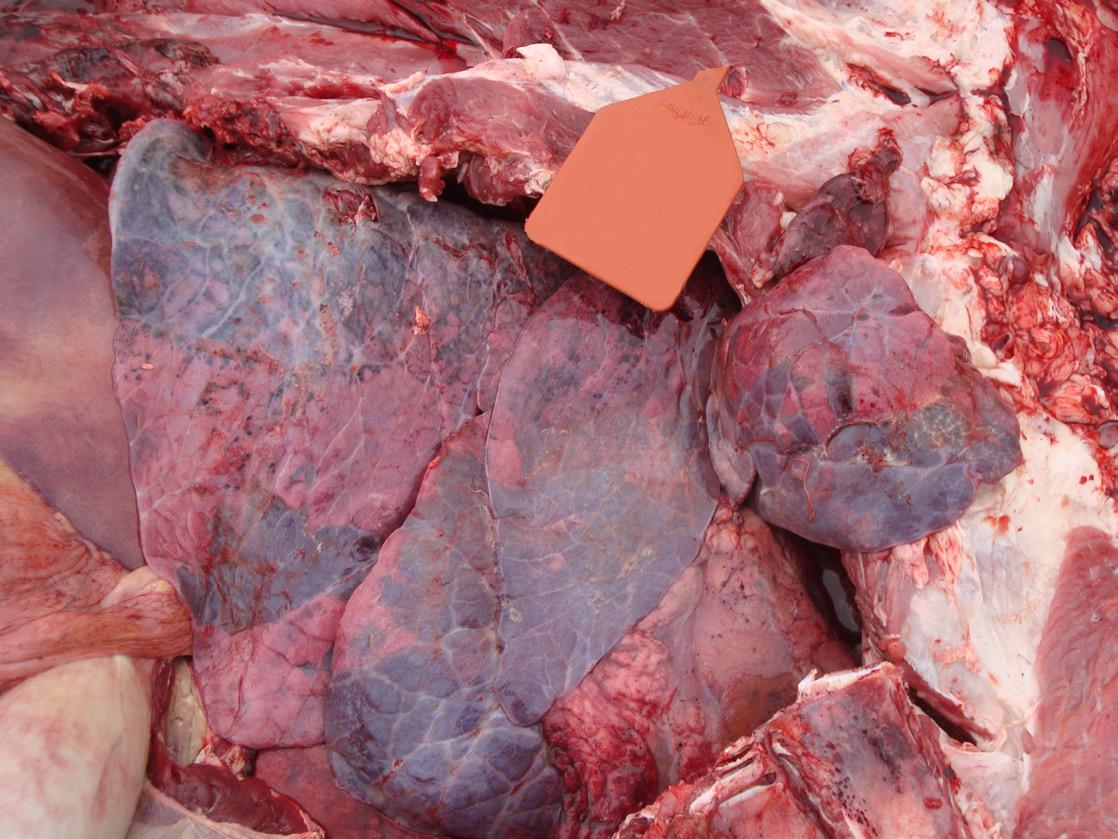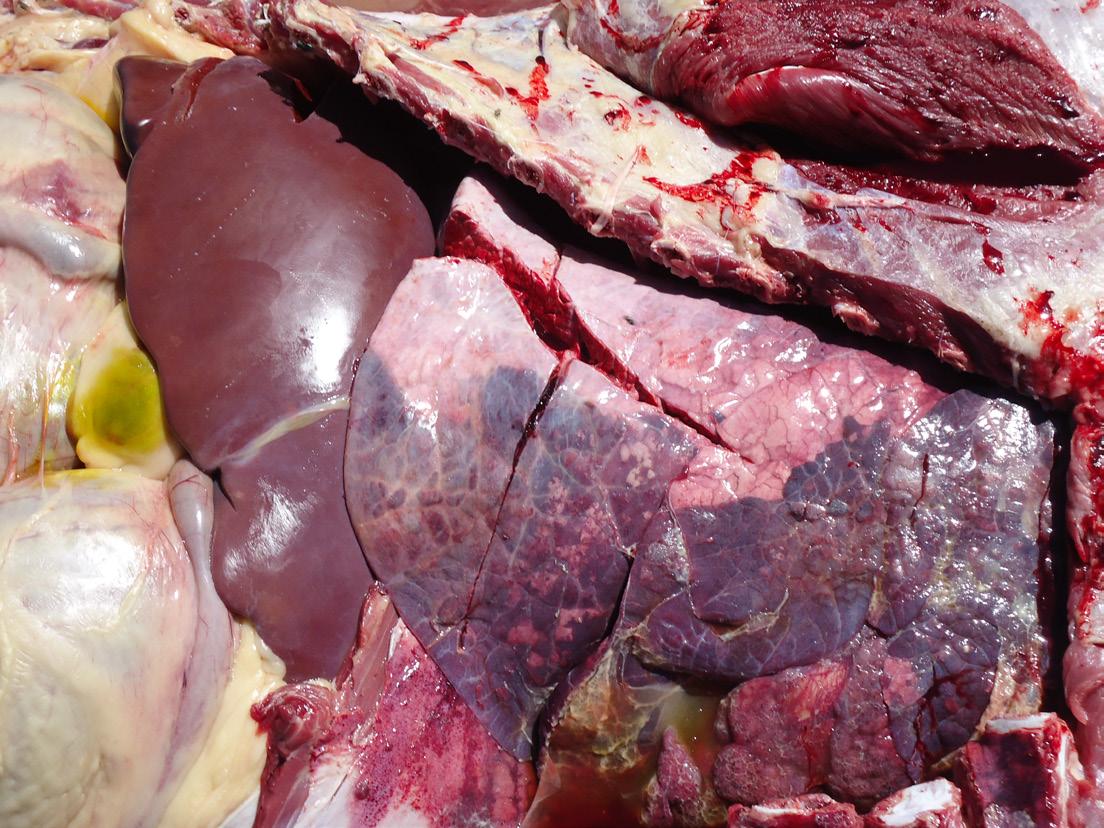
3 minute read
Clinical Case Review : Mannheimia haemolytica in Beef Cattle
By: Jose Valles and Lisa Taylor, Production Animal Consultation
Mannheimia haemolytica is a primary bacterial pathogen of bovine respiratory disease (BRD) in beef cattle and therefore causes significant economic loss for cattle operations through decreased cattle performance and health status. Previously known as Bacterium bipolare multicidum and Pasteurella haemolytica, this pathogen affects bovine and ovine populations worldwide.
Mannheimia haemolytica is a Gram-negative coccobacillus belonging to the Pasteurellaceae family. It is non-sporeforming, non-motile and facultative anaerobic. There are 12 serotypes of M. haemolytica; serotype A1 is most commonly isolated from the lungs of BRD cases.
There are two reasons why cattle get sick: 1) an overwhelming dose of a pathogen or 2) a suppressed immune system. Mannheimia haemolytica is a bacterium that normally inhabits the upper respiratory tract (nasal passages) of cattle without causing any negative health effects. However, when a calf’s immune system is suppressed due to calf stress or a viral infection (IBR, BVD, etc.), the bacteria are able to colonize and cause disease in the lung after being inhaled. Virulence factors of the bacteria such as leukotoxin and lipopolysaccharide cause pulmonary tissue damage, resulting in BRD.

Respiratory disease associated with M. haemolytica infection commonly follows stressful events such as a viral infection, changes in diet, changes in weather, commingling of cattle, long-duration transport and weaning. Proper management prior to shipping that reduces stress or improves immune status of beef cattle is important in preventing BRD in feeder cattle due to M. haemolytica.
Cattle sick with BRD associated with M. haemolytica commonly exhibit clinical signs such as going off feed, depression, standing alone, difficulty breathing, fever, grunting, coughing, nasal discharge and weight loss (Figure 1). These symptoms may vary depending on the severity of the disease and if the calf has a case complicated another bacterial or viral infection (either primary or secondary).
Recommended medical examination of cattle suspect of M. haemolytica infection includes rectal temperature, lung auscultation, visual clinical signs, feed intake, water consumption and movement. Cattle with BRD should be treated as soon as possible and then be closely monitored and provided supportive care.
The right cranial (towards head) lung lobe is the most commonly affected lung lobe in cattle BRD cases. Cattle affected by M. haemolytica commonly present acute fibrinous pleuropneumonia and cranial-ventral broncho-consolidation. This presents as a dark red area of the lung and the affected lung tissue is heavy and firm compared to the normal lung being spongy, pink and light. Common gross lesions found at necropsy include accumulation of fibrin, necrosis, and thrombosis of the lung lobes on the bottom/ front quadrant of the lungs. (Figures 2, 3)
Presence of M. haemolytica in the lower respiratory tract can be confirmed with bacterial culture while the calf is alive or dead. Samples from live cattle can be collected by bronchoalveolar lavage, tracheal swab, or transtracheal wash. Tissue samples from the lung of a dead calf can be collected at necropsy and sent to a diagnostic laboratory for bacterial isolation. Nasal and tonsil swab samples may test positive in healthy animals due to the bacteria’s commensal status in the upper respiratory tract. A newer diagnostic technology for diagnosing many BRD pathogens (bacteria or viral) at once is called multiplex polymerase chain reaction (multiplex PCR).
Early diagnosis and prompt treatment of cattle suffering from BRD are key in case success. Several classes of antibiotics are labeled for treatment of BRD; however, research has shown some isolates of M. haemolytica are resistant to particular classes of antibiotics. Working with your veterinarian is crucial to setting up case definitions and treatment protocols for antibiotic selection and judicious use in cattle feeding facilities. Supportive care is essential for all BRD cases.
Management practices aimed at reducing stress are the primary line of defense against disease outbreaks associated with M. haemolytica. Good animal handling practices as well as proper timing and methods for weaning and transportation are essential. Direct shipment of calves from ranch to feedlot is ideal to reduce morbidity. Feed and fresh, clean water must be available at all times. In addition to appropriate pen spacing and conditions, adequate bunk and water tank spacing is very important. Increased biosecurity measures including sanitation and reduction of commingling are key for disease prevention.
Bacterin, live culture, and subunit vaccines for M. haemolytica are available. However, evidence on the effectiveness of vaccination for M. haemolytica is inconclusive; some studies suggest vaccination may actually be detrimental to cattle health. If vaccine is used, cattle should be vaccinated at least 3 weeks prior to transportation and may be vaccinated again upon feedlot arrival. In some cases, high risk cattle may be given a metaphylactic dose of antibiotic at the time of feedlot arrival to reduce respiratory morbidity.
Consult with your veterinarian to determine appropriate vaccination protocols and management practices for your operation.
References
Campbell, J. 2015. Bacterial pneumonia in cattle. The Merck Veterinary Manual. Accessed February 16, 2016, from http://www.merckvetmanual.com/mvm/respiratory_system/respiratory_diseases_of_cattle/bacterial_pneumonia_in_cattle.html.


Campbell, J. 2015. Enzootic pneumonia of calves and shipping fever pneumonia. The Merck Veterinary Manual. Accessed February 16, 2016, from http://www.merckvetmanual.com/mvm/respiratory_system/respiratory_diseases_of_cattle/enzootic_pneumonia_of_calves_and_shipping_fever_pneumonia.html.
Irsik, M. 2010. Bovine respiratory disease associated with Mannheimia haemolytica or Pasteurella multocida. Institute of Food and Agricultural Sciences, University of Florida VM163.
Rice, J.A., L. Carrasco-Medina, D.C. Hodgins, P.E. Shewen. 2007. Mannheimia haemolytica and bovine respiratory disease. Animal Health Research Reviews 8(2): 117-128.










